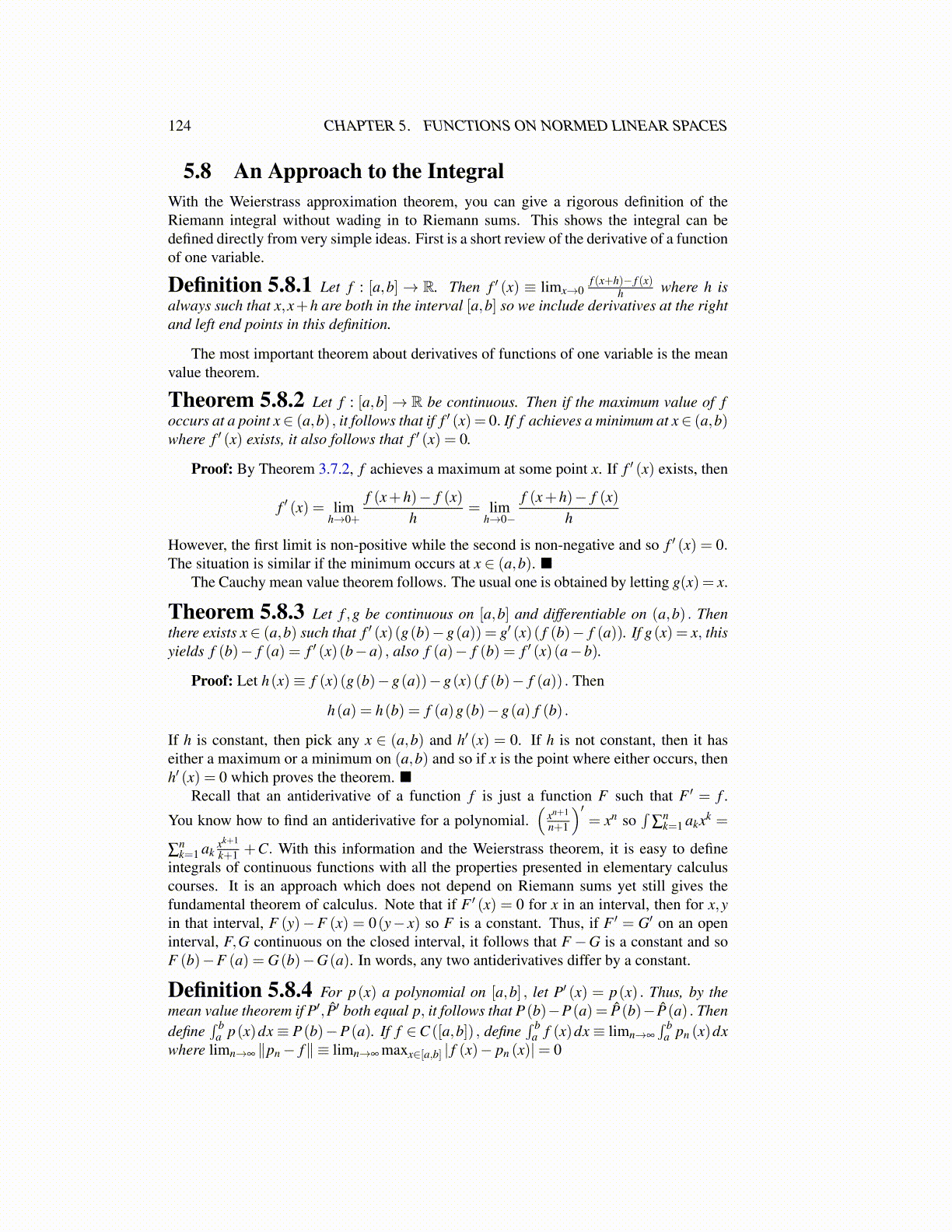
124 CHAPTER 5. FUNCTIONS ON NORMED LINEAR SPACES
5.8 An Approach to the IntegralWith the Weierstrass approximation theorem, you can give a rigorous definition of theRiemann integral without wading in to Riemann sums. This shows the integral can bedefined directly from very simple ideas. First is a short review of the derivative of a functionof one variable.
Definition 5.8.1 Let f : [a,b]→ R. Then f ′ (x) ≡ limx→0f (x+h)− f (x)
h where h isalways such that x,x+h are both in the interval [a,b] so we include derivatives at the rightand left end points in this definition.
The most important theorem about derivatives of functions of one variable is the meanvalue theorem.
Theorem 5.8.2 Let f : [a,b]→ R be continuous. Then if the maximum value of foccurs at a point x∈ (a,b) , it follows that if f ′ (x) = 0. If f achieves a minimum at x∈ (a,b)where f ′ (x) exists, it also follows that f ′ (x) = 0.
Proof: By Theorem 3.7.2, f achieves a maximum at some point x. If f ′ (x) exists, then
f ′ (x) = limh→0+
f (x+h)− f (x)h
= limh→0−
f (x+h)− f (x)h
However, the first limit is non-positive while the second is non-negative and so f ′ (x) = 0.The situation is similar if the minimum occurs at x ∈ (a,b). ■
The Cauchy mean value theorem follows. The usual one is obtained by letting g(x) = x.
Theorem 5.8.3 Let f ,g be continuous on [a,b] and differentiable on (a,b) . Thenthere exists x∈ (a,b) such that f ′ (x)(g(b)−g(a)) = g′ (x)( f (b)− f (a)). If g(x) = x, thisyields f (b)− f (a) = f ′ (x)(b−a) , also f (a)− f (b) = f ′ (x)(a−b).
Proof: Let h(x)≡ f (x)(g(b)−g(a))−g(x)( f (b)− f (a)) . Then
h(a) = h(b) = f (a)g(b)−g(a) f (b) .
If h is constant, then pick any x ∈ (a,b) and h′ (x) = 0. If h is not constant, then it haseither a maximum or a minimum on (a,b) and so if x is the point where either occurs, thenh′ (x) = 0 which proves the theorem. ■
Recall that an antiderivative of a function f is just a function F such that F ′ = f .
You know how to find an antiderivative for a polynomial.(
xn+1
n+1
)′= xn so
∫∑
nk=1 akxk =
∑nk=1 ak
xk+1
k+1 +C. With this information and the Weierstrass theorem, it is easy to defineintegrals of continuous functions with all the properties presented in elementary calculuscourses. It is an approach which does not depend on Riemann sums yet still gives thefundamental theorem of calculus. Note that if F ′ (x) = 0 for x in an interval, then for x,yin that interval, F (y)−F (x) = 0(y− x) so F is a constant. Thus, if F ′ = G′ on an openinterval, F,G continuous on the closed interval, it follows that F −G is a constant and soF (b)−F (a) = G(b)−G(a). In words, any two antiderivatives differ by a constant.
Definition 5.8.4 For p(x) a polynomial on [a,b] , let P′ (x) = p(x) . Thus, by themean value theorem if P′, P̂′ both equal p, it follows that P(b)−P(a) = P̂(b)− P̂(a) . Thendefine
∫ ba p(x)dx≡ P(b)−P(a). If f ∈C ([a,b]) , define
∫ ba f (x)dx≡ limn→∞
∫ ba pn (x)dx
where limn→∞ ∥pn− f∥ ≡ limn→∞ maxx∈[a,b] | f (x)− pn (x)|= 0